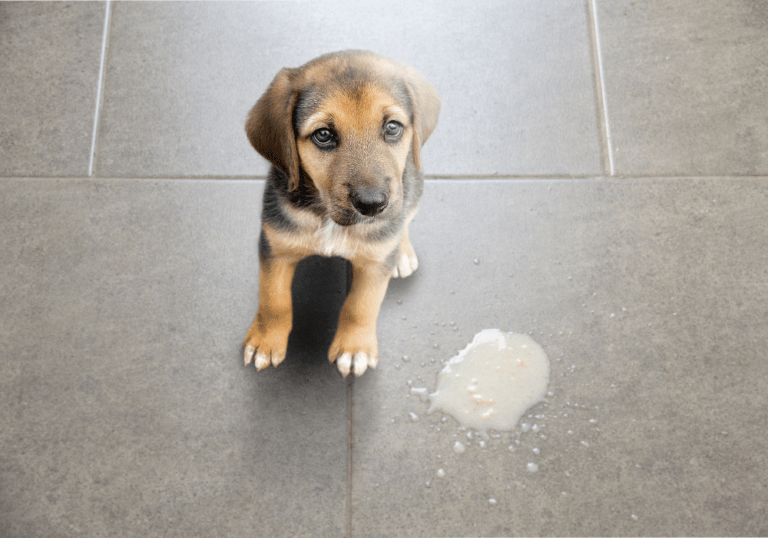Types of Dog Vomit & What It Means

As a pet parent, it’s essential to understand that not all dog vomit is created equal. Although it might not be the most pleasant topic to discuss, recognizing the different types of dog vomit can provide valuable insights into your canine companion’s health. Many dogs experience vomiting at some point in their lives, and understanding the color, texture, and consistency of vomit can help you determine when to seek veterinary care.
Types of Dog Vomit
There are various types of vomit, and the causes can differ widely. However, certain common characteristics can hint at the underlying issue. The color of the vomit can offer clues about what your pet has consumed or may indicate a medical condition. More vibrant colors like red or dark shades can signal serious health concerns.
Dog Vomit Color Guide
When it comes to dog vomit, color is one of the most telling features. If your dog throws up blood, represented by red or pink colors, you should contact our doctors at Willow Glen Pet Hospital immediately. Here’s a guide to common colors of dog vomit and what they may signify:
Color: White
- Possible Consistency: Foamy
- Possible Causes: Digestive upset, acid reflux, intestinal blockages, ingestion of toxins, regurgitation*.
Color: Clear
- Possible Consistency: Liquid
- Possible Causes: Nausea, indigestion, kidney or liver failure, toxins, regurgitation*.
Color: Green
- Possible Consistency: Firm or liquid
- Possible Causes: Bile, grass, indigestion, food allergies, toxins.
Color: Brown
- Possible Consistency: Firm or liquid, coffee grounds
- Possible Causes: Blood, poop, chocolate.
Color: Red or Pink
- Possible Consistency: Firm or liquid, coffee grounds
- Possible Causes: Blood, gastrointestinal disease, internal obstruction, blockage.
Regurgitation is distinctively different from vomiting. It is a passive expulsion of food or fluid without any nausea, salivation, or retching. Recognizing the difference between vomiting and regurgitation can be essential in helping your pet.
Consistency of Dog Vomit
The texture of dog vomit can vary widely, and here are some types you might see:
- Foam: Typically made up of stomach contents and saliva, white foam may indicate intestinal distress.
- Liquid: Thin, clear liquid may contain water, saliva, stomach secretions, or a mix of all three. Indigestion is likely, but more serious causes, such as toxins and heatstroke, are also possible.
- Chunky or Firm: This can consist of partially digested food. If your dog throws up after eating, they might actually be regurgitating their meal, meaning the food may not be digested at all. Non-food items can create a chunky consistency, especially in dogs that nibble on grass or other objects.
Dog Throwing Up Bile
Bile, produced by the liver and released into the small intestine, helps digest food. The presence of bile in dog vomit—characterized by yellow or green colors—can be concerning. This may indicate bilious vomiting syndrome, a condition where bile leaks into the stomach, often leading to early morning vomiting when the stomach is empty. Other conditions that irritate the stomach or alter intestinal motility can also contribute to this issue.
How to Help Your Dog if They’re Throwing Up
Understanding the types of dog vomit is crucial, but it’s equally important to comfort your pet if they are vomiting. Here are some steps you can take:
- Look for Other Symptoms: If vomiting accompanies diarrhea, lethargy, or other concerning signs, your dog may have a medical condition. Contact our doctors at Willow Glen Pet Hospital.
- Provide Love and Support: Some dogs may prefer solitude when feeling nauseous, but gentle affection and reassurance can help ease their discomfort if they are open to it.
- Consult Our Doctors at Willow Glen Pet Hospital: If your dog vomits once and you suspect a benign cause, you may not need to worry. However, if vomiting persists within a 24-hour period, becomes recurrent, contains blood, or features bright colors, it’s essential to consult our doctors.
As a responsible pet owner, understanding the color and consistency of your dog’s vomit can empower you to provide better care and potentially catch health issues before they escalate.
If you need more help or have any questions, call us at Willow Glen Pet Hospital, (669) 342-7472, 1033 Willow Street, San Jose, CA, 95125, US
Hours: Monday – Saturday 8:00 am – 6:00 pm
Dr. Gillon or Dr. Shani or visit us online.
